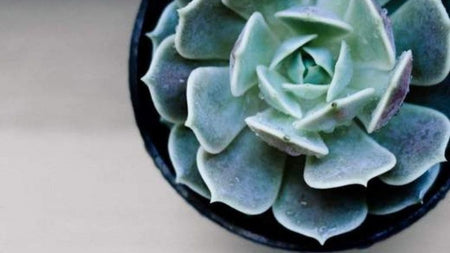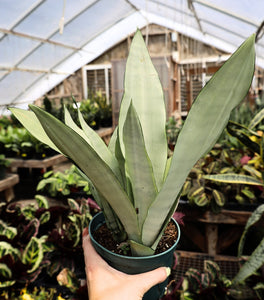
Images Depicted Range in Maturity & Container Size
Pots & Decorations Not Included Unless Otherwise Stated
Desert Rose: Sculptural Caudex and Tropical Trumpet Blooms
A Living Sculpture That Loves the Sun
The Desert Rose plant (Adenium obesum) is a flowering succulent that resembles a piece of modern art. A thick, swollen trunk (caudex) stores water like a miniature baobab, while glossy green leaves frame clusters of bright, trumpet-shaped blooms in shades of pink, red, and white. Native to arid regions of Africa and the Arabian Peninsula, the Desert Rose thrives in warm, sunny conditions with good drainage, rewarding good conditions with eye-catching color and a distinctive silhouette.
Caudex-Forming, Compact, and Bonsai-Friendly
Desert Rose naturally forms a stout, bottle-shaped caudex topped by branching, woody stems and clusters of leaves. In containers, plants typically reach 1–3 feet in height and width, depending on age, pot size, and pruning.
The slow to moderate growth rate makes it an excellent candidate for bonsai-style training: you can gradually expose more of the caudex, shape the canopy, and develop a unique, sculptural form over time. In warm, frost-free climates, the Desert Rose can be grown outdoors in the ground or in large planters. In cooler regions, it thrives as a sun-loving patio plant that is brought indoors for winter.
Full Sun, Sharp Drainage, and Soak-and-Dry Watering
Desert Rose is a true sun-worshipper. It performs best with at least six hours of direct sunlight daily, whether that’s on a sunny patio, balcony, or in a bright south- or west-facing window indoors.
The roots demand excellent drainage: use a cactus or succulent mix amended with coarse sand, perlite, or pumice so water runs through quickly and the caudex never sits in soggy soil.
Water on a “soak-and-dry” schedule—thoroughly drench the soil, let excess drain away, then wait until the mix is completely dry before watering again. During winter dormancy, watering is reduced drastically or paused entirely.
Desert Rose thrives in warm temperatures between approximately 70°F and 95°F and must be protected from cold. It is not frost-tolerant; plants should be brought indoors or sheltered when temperatures drop below 50°F.
Truly a Patio Star, Specimen Container, and Bonsai
In the landscape, Desert Rose is almost always used in containers where its caudex and branching structure can be showcased. On sunny patios and decks, it becomes a conversation-piece focal point in terracotta or decorative stone pots. In frost-free zones, it may be planted in raised, sharply drained beds as a small accent shrub. Indoors, it serves as a bright-window specimen, a sunroom feature plant, or a living bonsai on a stand or shelf. Pair Desert Rose with other drought-tolerant companions like sedums, dwarf agaves, and small cacti, or let a single plant stand alone to highlight its sculptural trunk and luminous blooms.

| Hardiness Zone: | Outdoors year-round in Zones 11–12; container plant elsewhere |
|---|---|
| Mature Height: | Typically 1–3 ft tall |
| Mature Width: | 1–3 ft wide in containers |
| Classification: | Flowering succulent shrub |
| Sunlight: | Full sun to very bright light; 6+ hours of direct sun ideal |
| Soil: | Very well-draining cactus/succulent mix with coarse sand or perlite |
| Flowers: | Warm season; showy trumpet blooms in pink, red, white, and bicolor selections |
| Water: | Soak-and-dry; water deeply, then allow soil to dry completely |
| Uses: | Patio and balcony containers, bright-window specimen, bonsai-style feature |
How to Care for Adenium obesum (Desert Rose Plant)
Before you buy a Desert Rose Plant, make sure to read about the recommended care instructions to keep this plant healthy and thriving.

How should I plant a Desert Rose plant?
To plant your Desert Rose, choose a container with generous drainage holes—terra cotta is ideal because it lets the soil dry quickly. Fill the pot with a sharply draining cactus or succulent mix; you can improve bagged potting soil by mixing in coarse sand, perlite, or pumice until it feels gritty and airy. Set the plant so the top of the root ball and caudex sit slightly above the final soil line, then backfill, gently firming around the roots without burying the swollen trunk. This elevated position helps shed water away from the caudex and discourages rot. After planting, water thoroughly to settle the soil and remove air pockets, then let the pot drain completely. Place your Desert Rose in a location with strong, direct sun and warm temperatures. In colder climates, plant in a container that can easily be moved indoors before nighttime lows dip below 50°F; treat it as a sun-loving patio feature in summer and a bright-window plant during the cooler months.
How often should I water a Desert Rose after planting?
During the growing season (roughly spring through early fall), Desert Rose prefers a soak-and-dry routine. Water deeply until excess drains from the bottom, then wait until the soil is completely dry before watering again. In warm, bright conditions, that may mean watering every 7–10 days, but the exact timing will depend on pot size, temperature, and sun exposure. The caudex acts like a built-in water gauge—firm and plump means hydrated; soft and wrinkled means the plant is thirsty. In winter or during cool, cloudy periods, Desert Rose often goes semi-dormant and may drop many or all of its leaves. At this time, drastically cut back watering—sometimes to once a month or less—or pause watering entirely if the soil stays cool and dry. Overwatering during dormancy is the fastest way to lose the plant. Always err on the dry side, and resume more regular watering only when days warm, light increases, and fresh buds or leaves begin to appear.
When should I fertilize a Desert Rose plant?
Fertilize your Desert Rose lightly during active growth, from spring through early fall. Use a balanced or bloom-boosting, water-soluble fertilizer diluted to half strength about once a month after watering. This supports new growth and encourages heavier blooming without overwhelming the roots. In particularly lean, gritty mixes, a slow-release succulent or flowering plant fertilizer at the start of the season can also help. Skip fertilizer in late fall and winter when the plant is resting, especially if it drops leaves and growth slows or stops. Feeding a semi-dormant Desert Rose can encourage weak, stretchy growth and increase the risk of rot. Instead, focus on proper light and temperature, then resume a light feeding schedule when warm weather and new growth return.

When and how should I prune a Desert Rose plant?
The best time to prune Desert Rose is in early spring, just before or as new growth begins. Use clean, sharp pruners and wear gloves—both to protect yourself from the plant’s toxic sap and to keep cuts neat. Remove any dead, shriveled, or crossing branches first. Then shorten long, leggy stems to outward-facing buds to encourage branching and a fuller canopy. Over several years, selective pruning can help you shape Desert Rose into a bonsai-like specimen with a sculptural caudex and layered branch structure. Avoid heavy pruning late in the season or during cool, low-light periods, as large cuts may heal slowly. After pruning, allow cuts to dry and callus; avoid overhead watering on fresh wounds, and keep the plant in warm, dry air while it recovers.


















